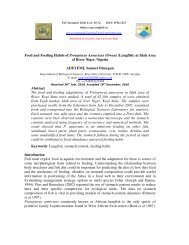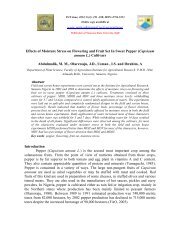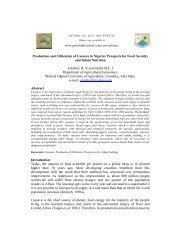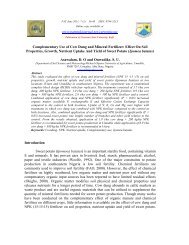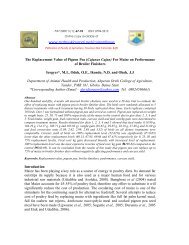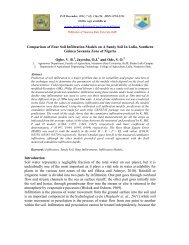View Publication - Production Agriculture and Technology Journal
View Publication - Production Agriculture and Technology Journal
View Publication - Production Agriculture and Technology Journal
You also want an ePaper? Increase the reach of your titles
YUMPU automatically turns print PDFs into web optimized ePapers that Google loves.
PAT 2012; 8 (1): 105-110: ISSN: 0794-5213; Eneje <strong>and</strong> Kalu,: Relationship between Aggregate Stability…...108Table 1: Physicochemical properties of plantation soils with depthPlantationtypeDepth of ofSampling(cm)S<strong>and</strong>/clayratioOrganicMatter(%)AggregateStability(%)ExchangeableSodium percentage(%)Rubber 0-15 1.13 5.34 0.72 2.03Rubber 15-30 0.72 2.36 0.8 1.58Pineapple 0-15 1.94 2.34 0.26 4.31Pineapple 15-30 1.68 1.71 0.28 3.88Oil palm 0-15 0.89 5.09 0.44 3.47Oil palm 15-30 0.52 3.89 0.29 4.66FLSD (0.05)P 0.32 0.79 0.25 1.7D 0.26 0.65 N.S N.SPXD N.S 1.1200.35 N.SGenerally for all the plantation type studied, aggregate stability was seen todecrease with depth except in the pineapple plantation soil. This may be due to the factthat the pineapple soils were mostly s<strong>and</strong>y (pineapple thrives well in well drained s<strong>and</strong>ysoils). This observation also supports the report that organic matter had a strongrelationship with the s<strong>and</strong>/clay ratio, as organic matter additions increased aggregationregardless of cation composition, as observed in this study (Figure 1), this observationagrees with an earlier report of Aldrich <strong>and</strong> Martin, (1954).The pineapple soils had the highest s<strong>and</strong>/clay ratio which reduced with depth in allthe plantations sites considered. The high s<strong>and</strong>/clay ratio in the pineapple soil probablyled to a low aggregate stability, this was also reported in a study by Kay <strong>and</strong> Angers,(1999) suggesting that clay content in the soil affected its aggregate stability. Theseobservations therefore supports the inverse relationship between s<strong>and</strong>/clay <strong>and</strong>aggregate stability observed in this study (Figure 1), as an increase in s<strong>and</strong>/clay ratio ledto a decrease in the aggregate stability in all the plantations considered. Theexchangeable sodium percentage was highest in the oil palm within the 15-30cm depth.This may be due to the high percentage of sodium in the exchange site relative to otherexchangeable cations. The exchangeable sodium percentage of soils decreased withdepth except in oil palm soil where it increased with depth. There was an inverserelationship between the exchangeable sodium percentage <strong>and</strong> the aggregate stability(Figure 1), this observation is supported by the report of Aldrich <strong>and</strong> Martin, (1954)that, as aggregate stability decreases the exchangeable sodium percentage increases.



